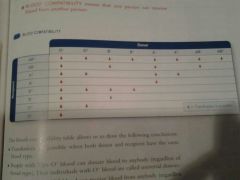![]()
![]()
![]()
Use LEFT and RIGHT arrow keys to navigate between flashcards;
Use UP and DOWN arrow keys to flip the card;
H to show hint;
A reads text to speech;
39 Cards in this Set
- Front
- Back
|
2 parts of blood |
Formed elements and plasma |
|
|
How can plasma and formed elements be separated |
Centrifugation |
|
|
Percent of formed element and plasma found in the blood |
FE= 45% P= 55% |
|
|
What is the main component of blood and what is the percent |
Water 90% |
|
|
Description of plasma and function |
Yellowish liquid, 90% water, nutrients, antibodies, hormones, waste dissolve in it Function: transports nutrients to cells, waste to excretory organs, transports hormones, antibodies, protein... |
|
|
Red blood cells description and function |
Red, biconcave disk, no nucleus, are all the same and has few organelles Function: transports oxygen with help of a protein called hemoglobin, transports CO2 |
|
|
White blood cells description and function |
Transparent, roundish in shape, have a nucleus, are of different kinds Function: provides immunity and defense against diseases |
|
|
How do the white blood cell provide immunity and defense against diseases? |
Producing antibodies and doing phagocytosis |
|
|
What is phagocytosis |
Ingulfing and destroying germs |
|
|
What happens to your WBC when you are sick |
They increase in number |
|
|
How does the RBC carry oxygen, what allows it to? |
The hemoglobin contains iron that attracts the oxygen allowing the white blood cell to carry oxygen to the body |
|
|
Hos long does a RBC live |
120 days |
|
|
Where are the RBC produced |
In the red bone marrow of our bones |
|
|
Why is a person who is lacking iron more tires |
BECAUSE RBC cant do a good job at carrying oxygen to your body cells |
|
|
What are the 8 types of blood |
A+, A-, B+, B-, AB+, AB-, O-, O+ |
|
|
What does it mean to be +(A+,B+) |
It means there is the Rh antigen found on the membrane of your RBC |
|
|
What are the 3 possible antigens found on your membrane |
antigen A, antigen B, antigen Rh |
|
|
Who is universal donor, why |
O- because it contains no antigen so it cannot give the recipient any foreign antigens |
|
|
Who is the universal recipient, why |
AB+ because it contains all the antigens so the recipient cannot inject any foreign antigen |
|
|
Who can receive from who, who can donate to who, all 8 |

|
|
|
What is blood transfusion |
Injection of blood into a person |
|
|
What is the transfusion rule |
The donor cannot give the recipient any foreign antigens |
|
|
What is immunity |
The capacity to resist a disease to which we have been exposed by being able to fight off the virus that causes the disease |
|
|
2 ways to become immune and why |
Vaccination and having had the disease because your body produces the specific antibodies to defend against the disease |
|
|
Why do we get a cold every year or so, more than once |
Because every cold is diferent, the antigens are different so our bodies have to re produce the specific antobodies for that specific cold |
|
|
How does a vaccine work? |
It injects weakened or dead antigens from a certain disease so that it triggers your WBC to produce the antibodies |
|
|
How does it work in your body when you have beaten the disease |
Your antbodies have outnumbered the antigens |
|
|
Artery def. |
Carries mainly oxygenated blood away from the heart to the body cells |
|
|
Describe artery |
Thick walls allow to withstand high pressure of blood |
|
|
Capillary description and def. |
Arteries branch out to smaller arteries that branch out to capillaries. Thin walls, like a single layer of cells, semi permeable memebrane allows for diffusion to occur Def. Blood vessel small diameter, thin walls in which exchanges between the blood and cell occur |
|
|
Vein description and def. |
Pressure in veins very low, has valves to keep blood flowing in right direction or from flowig backwards Def. Mainly carries deoxyginated blood back to the heart with the help of muscular contraxtions |
|
|
4 chambers of the heart |
Right and left atrium and right and left ventricle |
|
|
Heart, what is it? |
Organ that stimulatesnthe movement of blood, pump of cardiovascular system. |
|
|
What is the filling phase where the blood enters and fills the atrium called |
Diastole |
|
|
What is the contraction phase in which the atrium must contract to force the blood out called |
Systole |
|
|
What does the heart rate depend on |
Age, fitness, gender, physical activity |
|
|
What are the names of the 2 circulations? |
Pulmonary and systemic |
|
|
What is a extracellular fluid |
Clear liquid that surrounds our cells contans water, WBC and other substances found in plasma |
|
|
What is the lymph |
Fluid derived from extracellular fluid as it circulates nside lymphatic vessels to evacuate cell waste |

